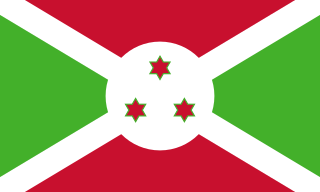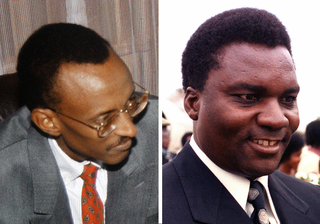
Burundi is one of the few countries in Africa, along with its closely linked neighbour Rwanda among others, to be a direct territorial continuation of a pre-colonial era African state.

Kigali is the capital and largest city of Rwanda. It is near the nation's geographic centre. The city has been Rwanda's economic, cultural, and transport hub since it became capital at independence in 1962. The city hosts the main residence and offices of the President of Rwanda and government ministries. The city is within the province of Kigali City, which was enlarged in January 2006, as part of local government reorganisation in the country. Kigali's city limits cover the whole province; it is consolidated. The city's urban area covers about 70% of the municipal boundaries.
Human occupation of Rwanda is thought to have begun shortly after the last ice age. By the 16th century, the inhabitants had organized into a number of kingdoms. In the 19th century, Mwami (king) Rwabugiri of the Kingdom of Rwanda conducted a decades-long process of military conquest and administrative consolidation that resulted in the kingdom coming to control most of what is now Rwanda. The colonial powers, Germany and Belgium, allied with the Rwandan court.

The Rwandan genocide, also known as the genocide against the Tutsi, was a mass slaughter of Tutsi in Rwanda during the Rwandan Civil War, directed by members of the Hutu majority government between 7 April and 15 July 1994.

Kigeli V Ndahindurwa was the last ruling King (Mwami) of Rwanda, from 28 July 1959 until the abolition of the Rwandan monarchy on 25 September 1961, shortly before the country acceded to independence from Belgium.
Mutara III Rudahigwa was King (mwami) of Rwanda between 1931 and 1959. He was the first Rwandan king to be baptised, and Roman Catholicism took hold in Rwanda during his reign. His Christian names were Charles Léon Pierre, and he is sometimes referred to as Charles Mutara III Rudahigwa.

The Rwandan Civil War was a conflict between the Rwandan Armed Forces, representing the government of Rwanda, and the rebel Rwandan Patriotic Front (RPF). The war, which lasted from 1990 to 1994, arose from the long-running dispute between the Hutu and Tutsi groups within the Rwandan population. A 1959–1962 revolution had replaced the Tutsi monarchy with a Hutu-led republic, forcing more than 336,000 Tutsi to seek refuge in neighbouring countries. A group of these refugees in Uganda founded the RPF which, under the leadership of Fred Rwigyema and Paul Kagame, became a battle-ready army by the late 1980s.

Yuhi Musinga king of Rwanda, came to power in 1896 and collaborated with the German government to strengthen his own kingship. In 1931 he was deposed by the Belgian administration because of his inability to work with subordinate chiefs and his refusal to be baptized a Roman Catholic. His eldest son, Mutara III Rwanda, succeeded him.
Since Burundi's independence in 1962, there have been two events called genocides in the country. The 1972 mass killings of Hutus by the Tutsi-dominated army, and the 1993 mass killings of Tutsis by the majority-Hutu populace are both described as genocide in the final report of the International Commission of Inquiry for Burundi presented to the United Nations Security Council in 1996.
The Kiga people, or Abakiga, are an ethnic group located in northern Rwanda and southern Uganda. The Kiga speak a Bantu language called Rukiga. They are sometimes referred to as the Chiga or Kiga, while the singular form is Omukiga. Additionally, a large number of Bakiga were still living in Rwanda at the time of European colonization. An Anglo-German Agreement signed in Brussels on 14 May 1910, modified part of the boundary between British and German territories initially established as the parallel of one degree south latitude by the treaty of 1890. Modified were the sectors between the Congo tripoint and the junction of the Kakitumba and Kagera, comprising the present Rwanda-Uganda boundary, and between the junction and the second crossing of the parallel of one degree south latitude by the Kagera, comprising the western segment of the present Tanzania-Uganda boundary. Details of the final delimitation and demarcation of the Rwanda-Uganda boundary between the Congo tripoint of Sabinio and the southwestern branch (Lubirizi) of the Tshinzinga (Muvogero) are given in an Anglo-German Protocol signed at Kamwezi on 30 October 1911. Therefore, many Bakiga became Ugandans by de facto in 1911 when the current international boundaries of Uganda were formally finalized.
The Hororo or Bahororo are a small nomadic Bantu tribe living in the north of the Kigezi District of Uganda. In 1905, they were described by a British officer as a "quiet, inoffensive people" who did not own cattle. They are made up mostly of the Hima. The Bahororo are more associated with Kigezi than Ankole. They reside mainly in Rujumbura in south western Uganda and are related to the Tutsi of Rwanda. Most Bahororo can trace their roots to the Buyumba region. The Bahororo speak a dialect of Nkore-Kiga, Ruhororo, and are subdivided into clans most of which are common to both the Nkole and Kiga nations.
The Banyarwanda are the cultural and linguistic group of people who inhabit mainly Rwanda. Within the Banyarwanda there are three subgroups: Hutu, Tutsi and Batwa. Some Banyarwanda live in the Democratic Republic of the Congo, having migrated there from neighbouring Rwanda in waves. In the Congo, they live in the provinces of North Kivu and South Kivu. There are also 1 million Banyarwanda in Uganda, where they live in the west of the country; Umutara and Kitara are the centres of their pastoral and agricultural areas.

Hutu Power is a racist and supremacist ideology propounded by Hutu extremists in Rwanda. It led to the 1994 Rwandan genocide against the Tutsi. Hutu Power political parties and movements included the Akazu, the Coalition for the Defence of the Republic and its Impuzamugambi paramilitary militia, and the governing National Republican Movement for Democracy and Development and its Interahamwe paramilitary militia.
The largest ethnic groups in Rwanda are the Hutus, which make up about 85% of Rwanda's population; the Tutsis, which are 14%; and the Twa, 1%. Starting with the Tutsi feudal monarchy rule of the Tenth century, the Hutus were a subjugated social group. It was not until Belgian colonization that the tensions between the Hutus and Tutsis became focused on race, the Belgians propagating the myth that Tutsis were the superior ethnicity. The resulting tensions would eventually foster the slaughtering of Tutsis in the Rwandan genocide. Since then, government policy has changed to recognize one main ethnicity: "Rwandan".
Alexis Kagame was a Rwandan philosopher, linguist, historian, poet and Catholic priest. His main contributions were in the fields of ethnohistory and "ethnophilosophy".
The Rwandan Revolution, also known as the Social Revolution or Wind of Destruction, was a period of ethnic violence in Rwanda from 1959 to 1961 between the Hutu and the Tutsi, two of the three ethnic groups in Rwanda. The revolution saw the country transition from a Belgian colony with a Tutsi monarchy to an independent Hutu-dominated republic.
Gihanga is a Rwandan cultural hero described in oral histories as an ancient Tutsi king popularly credited with establishing the ancient Kingdom of Rwanda. Oral legends relate that Gihanga introduced foundational elements of the African Great Lakes civilization, including fire, cattle, metalworking, hunting, woodworking and pottery. He is described as possessing talents in leadership, technology and religion. It is said he ruled Rwanda from his palace in the forest of Buhanga, an area that retained its forbidden and sacred status until the government opened it to the public in 2004. No concrete evidence exists to indicate that Gihanga lived, although many Rwandans believe that he was a living king.
Ibitekerezo is a form of epic hero poetry that was performed at the royal court in precolonial Rwanda. This oral tradition serves to explain the history of Rwandan dynasties in poetic form. It is one of four major royal traditions of the Kingdom of Rwanda alongside ubwiru and the oral literature forms ubucurabwenge and ibisigo. Ethnographers Jean Hiernaux and Emma Maquet recorded several major ibitekerezo.








